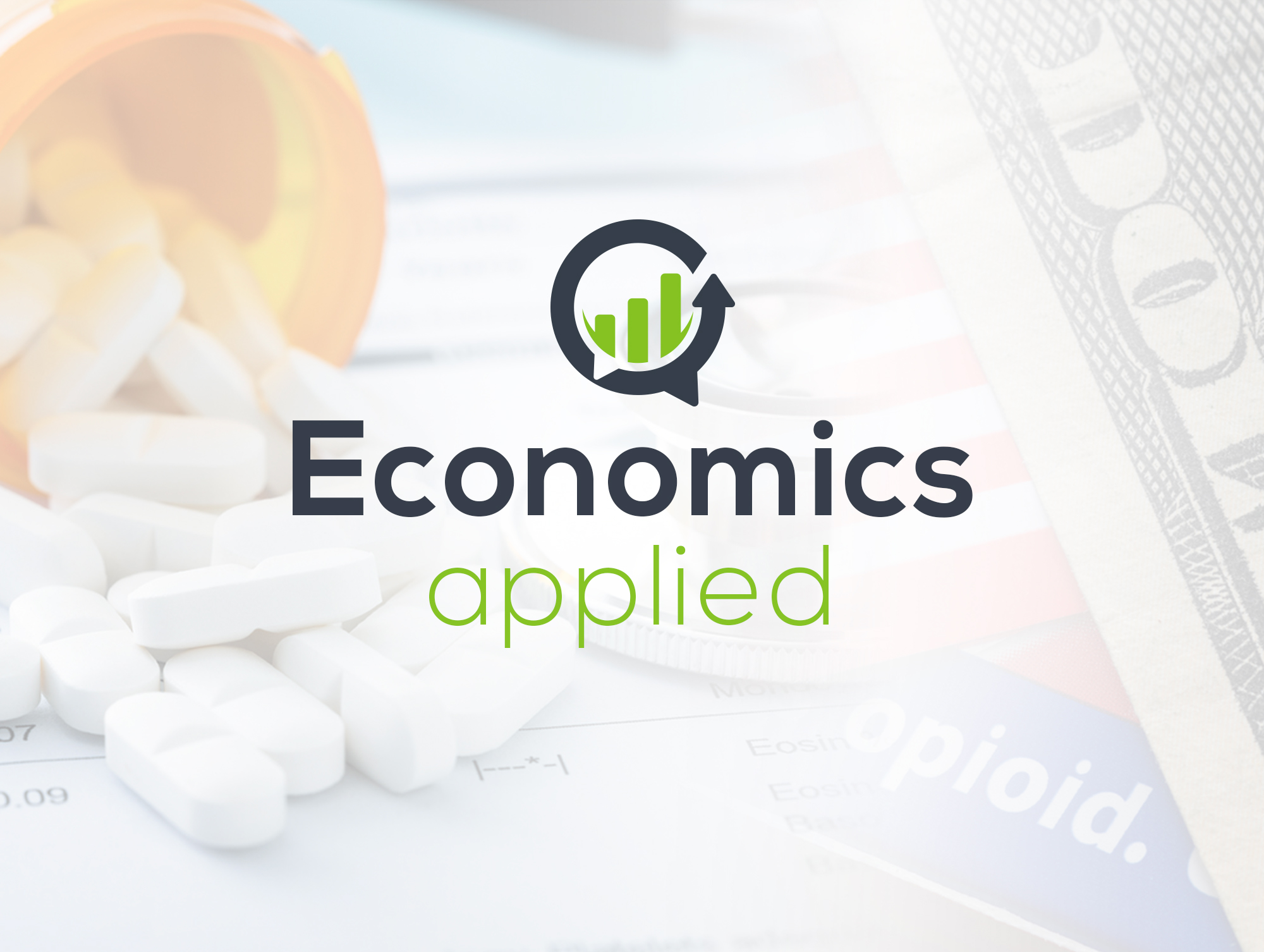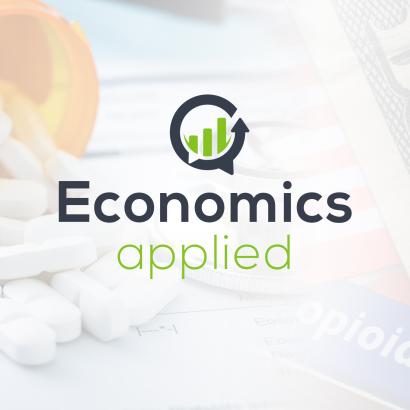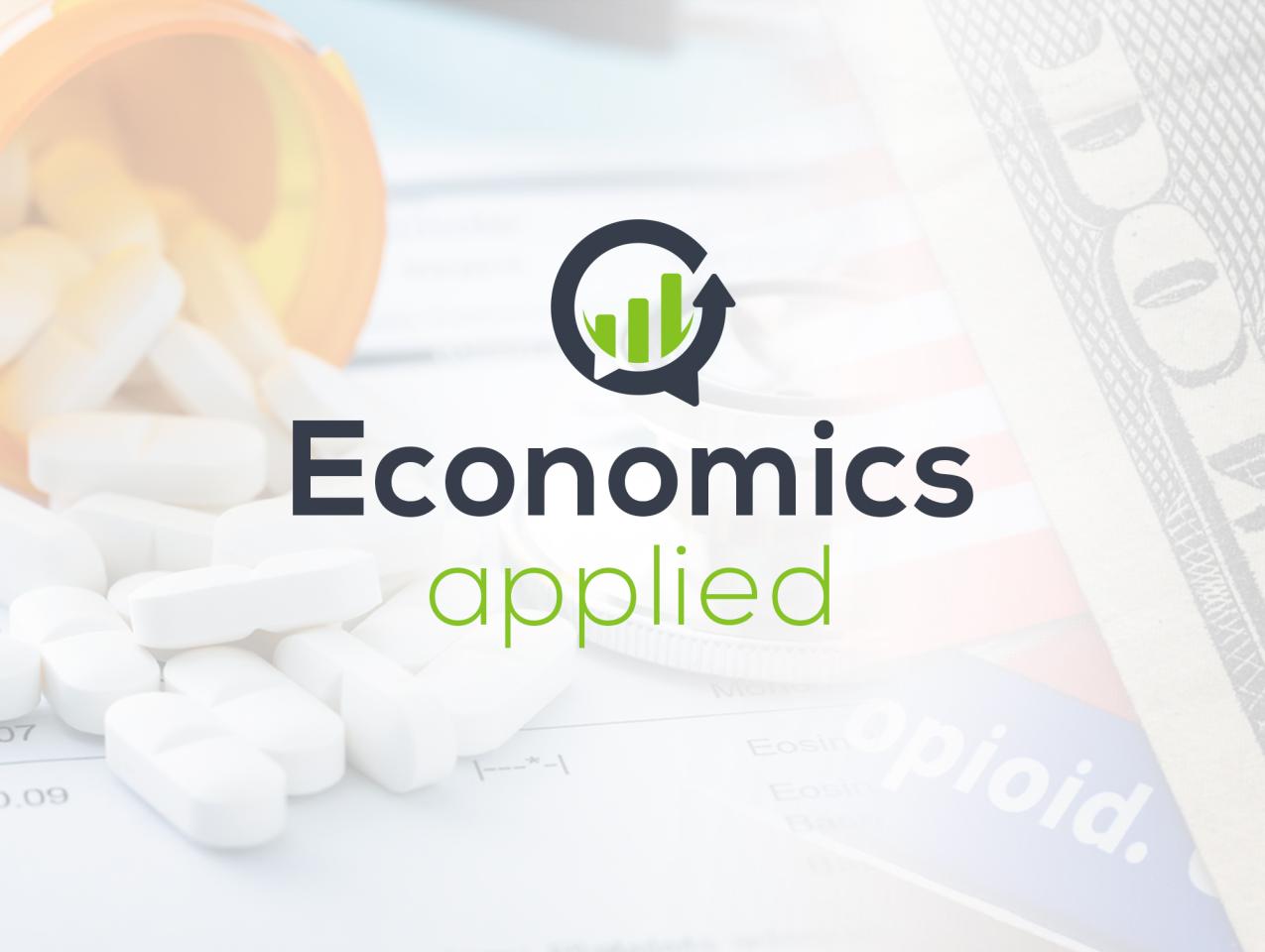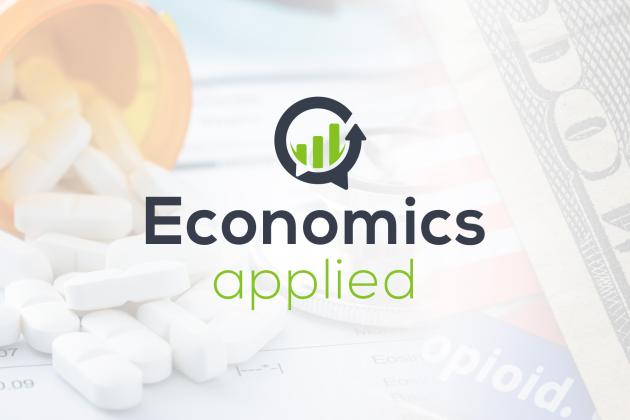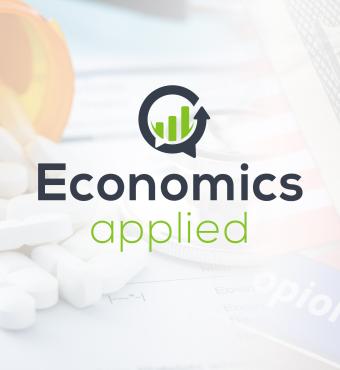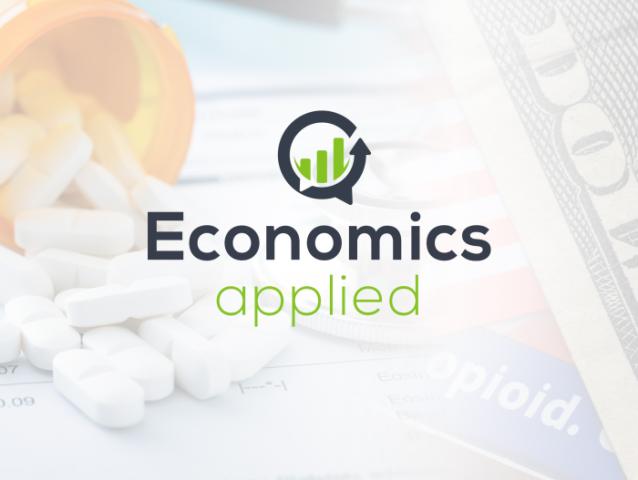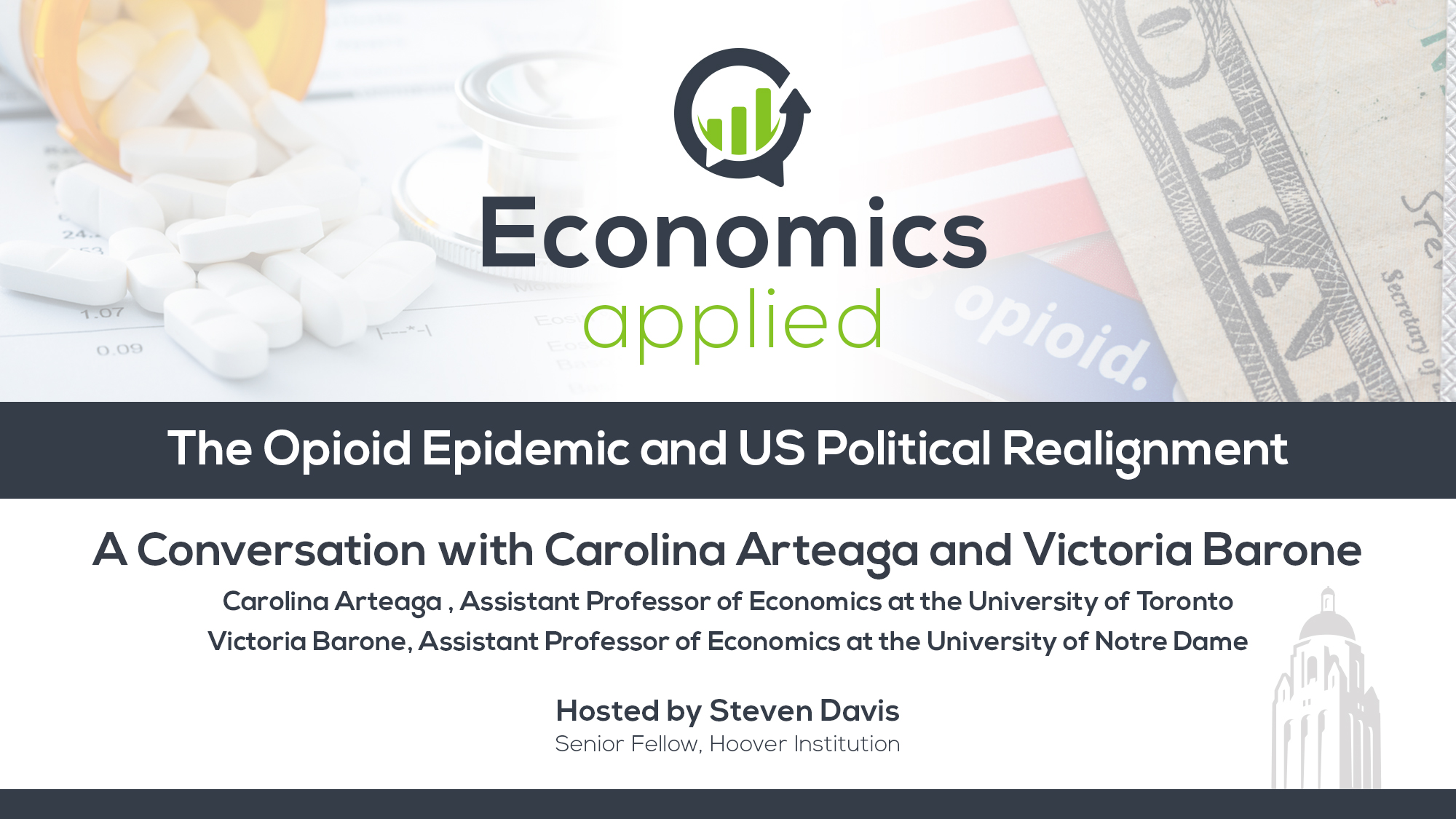- Economics
- Politics, Institutions, and Public Opinion
- Answering Challenges to Advanced Economies
Steven Davis speaks with Carolina Arteaga and Victoria Barone about the US opioid epidemic. They discuss Purdue Pharma’s marketing strategy, its influence on physicians, and policy factors as drivers of the epidemic. Next, they consider economic consequences, the odd character of how the media covered the epidemic, the (slow) response of most politicians to a mounting tragedy, and how – over time – the opioid epidemic and its fallout drove a major political realignment in the United States.
Recorded on June 24, 2025.
WATCH THE VIDEO
>> Steven J. Davis: The opioid epidemic has had devastating consequences for many Americans and their families and for many communities throughout the country. The epidemic also drove a political realignment from the Democrats to the Republicans. That's according to our guests on today's show.
>> Steven J. Davis: Welcome. I'm Steven Davis, and this is Economics, Applied, a podcast sponsored by the Hoover Institution.
With me today are Carolina Arteaga and Victoria Barone. They are authors of a recent study that develops new evidence on how and why the opioid epidemic unfolded in the United States. Second, the impact on drug-related deaths, economic hardship, and government spending on public transfer programs. Third, how the news media covered or neglected the opioid epidemic and its fallout.
Fourth, how politicians responded to the pandemic. And finally, how all this came together to drive a major political realignment that favored Republicans. We will delve into each of these topics in today's show. But first, let me introduce our guests. Carolina is assistant professor of Economics at the University of Toronto.
Her research focuses on health outcomes, political economy, education, and crime. She grew up in Colombia and earned her PhD in economics at UCLA. Victoria is assistant professor of Economics at the University of Notre Dame. Her research interests lie in public labor and health economics. She grew up in Argentina and also earned her Ph.D.
in economics at UCLA. Welcome to both of you. It's great to have you on the show.
>> Carolina Arteaga: Thank you for having us. Pleasure to be here.
>> Victoria Barone: Thank you, Steve, for the invitation. It's great to be here.
>> Steven J. Davis: We're glad to have you. So, as I've already indicated, there's a lot in your paper.
Why don't you start by just laying out for us the broad background with regard to the scale, the character and the scope of the opioid epidemic as it unfolded in the United States, so that our listeners and viewers have some baseline for understanding the analysis that you're going to layer on top of that experience.
>> Carolina Arteaga: So the opioid epidemic is one of the largest public health crisis in the history of the US or at least in the in the past decades or in the past century. And it has taken the lives of hundreds of thousands of Americans from all across the country.
But beyond that, it has changed the fabric of the communities that have been most affected by the epidemic. And we see that in terms of poverty levels, disability, the number of children that are growing up in foster care. So it's really something that has deeply transformed the communities that have experienced the largest impacts of this epidemic.
So in the past years, there's been a lot of work trying to really make sense or quantify where are these effects. And this is where our work comes in, in trying to take a community view of what are the economic consequences of the opioid epidemic, Thinking of broad outcomes, such as just broad economic effects, but also if given the size of those effects, how could that then also change political views, political preferences?
And that's where our paper comes into the-
>> Steven J. Davis: So what we think of as the opioid epidemic. Of course there are opioid drug related deaths for decades in the United States, but when we refer to the epidemic, we're really talking about the period that started in the second half of the 90s, is that right?
In the wake of a big expansion of, of prescriptions of OxyContin and that spread out to other opioids and eventually illegally, a big expansion in illicit opioids. But the consequences played out over the next two decades or so, according to your analysis. Right, but things began in 1996 or if I got it right, yes, yes, that's correct.
And as I understand the story, at least as you tell it, is Purdue Pharma played a central role, especially early on, in the expanded use and in some cases abuse of prescription opioids. So explain what the role of Purdue Pharma was and how it at least initiated the opioid epidemic.
>> Carolina Arteaga: So in the mid-90s, opioids were largely absent from the treatment of moderate or chronic pain. Opioids were only used for cancer pain or for terminal end of life pain. And in the mid-90s, the gold standard drug to treat cancer pain was a drug called MS Contin that was produced by Purdue Pharma.
However, this drug was about to face generic competition starting in 96. So Purdue Pharma wanted to develop a new drug to take over that market that they had, that they had ownership of for quite some time. But they also saw this as an opportunity to expand to the much larger non terminal pain or non cancer pain.
A market in which opiates were mostly absent from. And they were absent because there were previous experience with the use of opiates that had led to serious issues of addiction and dependence. But they saw this as an opportunity to launch this new drug that would have, in their words, like a different personality.
And they would try to market this to the much larger chronic pain market or non terminal pain market. Yes.
>> Steven J. Davis: Was there any medical basis at the time for thinking that these new versions of opioids would not have the addictive consequences that had long been recognized in previous decades with opioids?
Was there anything, or was it just a pure marketing shift that drove?
>> Carolina Arteaga: So there was this technological development that was both present in Ms. Contin and oxycontin, which is what the Contin word comes from, which is there is a continuous release of opioids. And so the idea of this is that because the release of the active ingredient is going to be slow in the system, that's going to lead to lower degrees of addiction and of like, a high.
The issue with this is that continuous release is only real if you take the pill as indicated. But if you do something as simple as just crushing the pill, then you're gonnareceive the full dose of the Tablet rather than but that was, I mean that was true. But it's not like there were studies that would say that continues release, even taking as prescribed, would lead to lower dependence or lower addiction rates.
>> Steven J. Davis: You're saying there were no such studies. This was a hope rather than a demonstrated change in the consequence of taking.
>> Carolina Arteaga: Exactly, and they were actually their sales representatives, were article from the New England Journal of Medicine that said that the risk of addiction using opiates was lower than 1%.
However, this was not a real like paper published in this journal. This was a letter to the editor from some physician that was just like recalling sounds like his own private practice, just like by following his patients. And this was cited as scientific evidence from a major medical journal.
>> Steven J. Davis: So one thing about this story that makes me worried is it sounds like practicing physicians were easily persuaded or deceived by Purdue Pharma that.
>> Carolina Arteaga: Yeah, I mean, there is a large literature in pharmaceutical marketing that shows that physicians believe that they're not persuaded by pharmaceutical promotions and marketing and so on.
But the data shows that they are. The data shows that these are very effective tools to get physicians to prescribe whatever pharmaceutical companies are producing. And there is no internalization of the fact that this is happening on the side of the physicians.
>> Steven J. Davis: Okay, so again, leave me a bit concerned about what drives the prescriptions offered by my physicians and others.
So there's an important connection, as I understand it, correct me if I'm wrong, important connection between the Purdue Pharma marketing strategy. And their recognition of the different prescribing behaviors of oncologists who treat cancer patients and other physicians. Is that right? So there was already, and you pointed this out earlier, there was a history of the use of opioids to treat cancer pain and terminal patients, often terminal because of cancer.
So there was already an understanding that, at least among that class of physicians, that opioids had a certain appropriate use and the avoidance, but other physicians avoided it, right? And so that was the situation as of the mid-90s.
>> Carolina Arteaga: So, yes, except that. So the group of patients that were using opioids before were cancer patients, but a lot of their prescriptions were coming from their primary care physicians.
So they will first receive their first prescription from their oncologist, but like their ongoing treatment, will be through their family practitioner or general practitioner. And then the idea for Purdue Pharma is to use those cancer patients who see a family care doctor to inform this family care doctor about this new drug that they could also prescribe to the non-cancer patients.
So it's a spillover story from cancer patients to non-cancer patients through their shared family, practitioner or GP.
>> Steven J. Davis: Okay, but the reason I'm drilling in on this, it's an important part of how you assess the consequences of the marketing behavior by Purdue Pharma and the spread of opioids, the uneven spread geographically.
So I want to understand it carefully. So is it true, aside from just your study, that physicians. Is there evidence that physicians learn a lot from or learn or not, but they mimic to some extent the prescribing behavior of other physicians in their local area? And so there's a tendency, there's at least a possibility that prescribing behavior could spread within a local market, from first oncologists, then to the GPs who had cancer patients, the general practitioners, to others.
Is that, I mean, because there was some understanding of prescribing behavior that drove the Purdue Pharma marketing strategy? So could you just elaborate on that a bit?
>> Carolina Arteaga: So I don't think we're not relying on that style of spillovers in prescribing behavior across different physicians. So this is more coming from on the patient side.
So this is just patients that inform their doctors about like this new drug that is gonna take over their previous pain treatment, but now has this broader. Now is marketed for a broader market. And-
>> Steven J. Davis: So, but wait, that sounds a little odd to me. So now you're making it sound as if the patients are convincing that their doctors should prescribe OxyContin, for example, to other patients.
>> Victoria Barone: I guess just, okay, maybe let me kind of like chime in here. What we are going to learn from the marketing documents of Pythopharma is that the reading of the situation and there is kind of like evidence showing in our paper and other papers. There was a kind of like shift in how comfortable physicians were prescribing opioids for non-terminal pain.
And in part, this shift was pushed by Purdue Pharma and the marketing campaign, where the idea was that these opiates weren't as addictive as we now know they are. So kind of like what we are going to leverage in our paper is the fact that Perdiopharma was one of the main actors in the cancer pain market with this drug, as Carolina was explaining before, called Ms Contin.
And now in these areas where MS Contin was, let's say, a popular drug that most of your patients are already being prescribed, though for terminal pain. Now physicians will get more comfortable by prescribing this successor of Ms. Contin, which is OxyContin for non-terminal pain. And that's kind of like what we're going to pick up to kind of like help us identify which areas were more exposed or less exposed to the opioid epidemic.
So to the beginning, okay? So this initial push on the use of prescription opioids and something that it's also important to highlight here is that even though we in our paper rely on the marketing documents of Purdue Pharma. We also learn in these documents and related documents that it's not the only pharmaceutical company that was pushing this strategy.
In fact, we have some quotes in the paper that show that other pharmaceutical companies were trying to gain terrain against Purdue Pharma. So there was this big push into what do physicians are comfortable prescribing opioids for. And these conditions were expanded to incorporate this non cancer crime.
>> Steven J. Davis: So just a note first for listeners that the Purdue Pharma marketing documents became available as a consequence of litigation.
So I understand. So that's just why you have this unusual access to contemporaneous marketing documents. Still, here's what I'm puzzled by. Why is it that Purdue Pharma and other pharmaceutical companies at the time didn't just say, well, we're going to try to market oxycontin or ms.contin broadly across the country.
Because your story is that they did so very unevenly by focusing their marketing efforts more intensively in parts of the country that had high cancer rates, all right? If I got that correct. But if it really is about persuading physicians to become more comfortable with the use of opioids for non cancer, non terminal patients, if you think you have a viable strategy to do that, why didn't they just do it broadly across different areas of the country rather than focusing on those areas that as of the mid-90s had a high incidence of cancer?
>> Carolina Arteaga: So in their internal documents, they're going to have focus groups and they're going to discuss what do they learn about the focus groups. They're trying to introduce this new drug. And it's clear from those focus groups that there is no enthusiasm around using opioids for non cancer pain.
So if we go Back to the mid-90s, this is a world in which.
>> Steven J. Davis: Focus groups of physicians.
>> Carolina Arteaga: Focus groups of physicians. Yes, exactly. When they're introducing the drug, they're telling them about what is at this drug, what are the benefits, what is this drug about. And like how should it be prescribed?
Cancer patients are very excited about this new drug. Cancer physicians are very excited about this drug. Physicians that are not prescribing to cancer patients, there's no enthusiasm about taking up or starting to prescribe this drug for non cancer patients. And this is because there is a lot of stigma around the use of opiates for this type of pain.
There is a lot of evidence that shows that this is extremely dangerous, that it is highly addictive. So they know that they cannot just tap into that market yet they need to ease into that market. And the strategy that they devise is, well, let's start with the physicians that are already comfortable using opioids, that they're using it for their cancer patients.
They see how this can be used in an appropriate way. And if we just tell them that this new drug has some additional benefits and that can be prescribed for a broader set of conditions, maybe they are the ones that are going to be able to be comfortable using this drug in a broader set of conditions.
But this, I mean, even outside of the United States, opioids are rarely used for non cancer pain or non terminal pain because there is real fears. I mean, now we know that a lot of these fears and stigma is completely valid because it is very dangerous. So it wasn't as easy to just like, let's just try to go into the Larger pain market.
>> Steven J. Davis: So that's the description of the marketing strategy. But of course, in your paper you then go on to show that in fact the opioid epidemic did unfold in the way that was. I don't know what the right word is here, a validation of the Purdue pharma marketing strategy in the sense that it worked.
Okay, so why don't you tell us about that evidence and here we'll get. I'm referring to the uneven expansion of opioid use and abuse in the United States followed the pattern that was suggested by these marketing documents. So tell us about that.
>> Carolina Arteaga: So I remember exactly. And this was many years ago when I was reading the internal documents and I was like reading these references to the cancer pain over and over again in different depositions and internal documents.
And I go back to Vicky and I'm like, well, the only thing that I keep on reading is this reference about how they were really after the cancer pain market. And then Vicky comes back to me with this figure that is just splitting. Counties are commuting zones in the US by their level of cancer.
The top quartile and the bottom quartile of cancer incidents in 96, which is the time in which all of this is unfolding. And you see this very stark graph in which before the mid-90s, these places are not on a differential trend at all in terms of their mortality, opioids or for many drugs.
And even in terms of their level of prescription of opioids, there is a level difference, but not that large. But then soon after, these places diverge completely. And so the, the path of like the high cancer places is going to look very, very different than the future path of the low cancer places.
And this is just a massive influx of opioids that is going to translate into excess mortality from.
>> Steven J. Davis: All right, and just to be clear, make sure it's clear, as I understand you here, there was a big increase in the use of opioids in these high cancer commuting zones or counties.
Doesn't mean it was necessarily used to treat cancer. It was the expansion of the use of opioids beyond cancer patients and those who are terminally ill.
>> Carolina Arteaga: Exactly.
>> Steven J. Davis: Yes, okay.
>> Carolina Arteaga: Because the cancer patients were already being treated by with opioids. They were already being treated with morphine.
So the previous drug, the predecessor, mscontine, is a morphine based opioid, whereas oxycontin is an oxycodone based opioid. But there are opioids nonetheless. And there is an Equivalence between the two drugs. And it's not that there is an increase. There shouldn't be an increase if you're just switching from one drug to the other.
What we see is just that the increase in opioid prescription and opiate consumption is just far more than what the level of demand for the cancer market would.
>> Steven J. Davis: Right, okay, in this part of your study, you've got lots of statistical evidence. You can see it in your tables, but also visually in your graphs.
This divergence you referred to. And it's the divergence with respect to the extent of opioid prescriptions per capita, it's the divergence in drug related overdose deaths. And also, so that's a big part of just showing that there was a marketing strategy that was articulated in these internal documents revealed by the litigation.
That marketing strategy then played out pretty much as it was designed and it was effective, right? But it played out over many years. So this divergence takes place over many years, which suggests there was a gradual erosion of the resistance to prescribing opioids to something other than cancer patients and those who were terminally ill.
Correct. So the stigma, at least in some of these communities, among many prescribing doctors, is gradually being dissipated through this successful marketing strategy. I got that right?
>> Carolina Arteaga: Yes.
>> Steven J. Davis: Okay, and maybe you wanna just tell us more about the timing, okay? Cuz this didn't happen over three, four years.
It happened over a much longer stretch, this divergence. So just give us a little bit more information about that.
>> Carolina Arteaga: So OxyContin enters the market in the middle of 1996, and they're still going to be the first year after the introduction of the drug in the market. The amount of opioids that are going to be dispensed in the contrast are still low compared to what's coming after.
But soon after the introduction of the drug, you start to see that there are reports of addiction and misuse. And this is something that the media is reporting from as early as 1997. And some physicians are also realizing that there is something wrong with this, with how this drug is being prescribed.
So there's letters to the DEA, there's letters to the FDA, and letters to Congress that happened as early as 2001. The district attorney of Maine and West Virginia, if I'm not wrong, are informed about these issues. And there's class actions against Purdue Pharma. But opioids continue to grow.
The prescription of opioids continues to grow all throughout this period. The level of abuse continues to grow. We start to see the appearance of pill meals at some point, which are basically doctors that sell prescription of opioids. Yes.
>> Steven J. Davis: Just when you say grew throughout this period, what's the period?
>> Carolina Arteaga: So opioids are going to peak in 2011. The prescription of opioids are going to peak in 2011. So this is going to be 15-
>> Steven J. Davis: 15 years later, 15 years after the introduction of OxyContin, is that correct?
>> Carolina Arteaga: Yes, this is gonna be 15 years of continuous growth with some.
During this period, different states are introducing prescription monitoring programs to try to at least have a sense of who is prescribing in terms of like is, are there physicians are over prescribing? Are there patients that are receiving prescription from different physicians? Something to at least be able to have some numbers on how these things are evolving.
But none of this really reduces the amount of-
>> Steven J. Davis: So the expansion continues for 15 years. But critical for the later parts of your analysis, the expansion is unfolding to a very different extent in different parts of the country, Both because the initial distribution of cancer patients, which drove the marketing strategy, differed a lot as of the mid-90s and continued on, but also because some states took steps to try to restrain the misuse and over prescription of opioids.
Correct?
>> Carolina Arteaga: Yes, but I mean, the success of these strategies is gonna be very limited. So there's been a series of papers that try to evaluate the success of these especially PDMPs, like prescription monitoring programs. And then the reality of that is that each state is going to have kind of like their own version of it.
The implementation of it is going to vary a lot across states. So at best they had very limited success in terms of the prescription of opioids.
>> Steven J. Davis: Okay, so uneven expansion, different parts of the country over 15 years after the introduction of OxyContin. And you also provide evidence in your paper that the areas that experienced big increases in prescription rates of opioids and big increases in drug related overdoses also had other signs of economic hardship, like more people showing up on Social Security disability rolls, more people collecting SNAP food stamps colloquially and so on.
So you provide evidence on that as well, that suggests, at least strongly suggest, that even when the misuse of opioids wasn't leading to outcomes as severe as an overdose, a death by overdose, it still is debilitating many people and leading to other forms of hardship. And hence they turn more to certain forms of public transfer programs supported by the taxpayer.
Have I got that right?
>> Carolina Arteaga: Yes. I mean, the number of deaths, that's the worst possible outcome of the opioid epidemic. But that's just like the tip of the iceberg. If we look at the numbers in terms of share of the population that misuses opioids or that is addicted to opiates, that's going to be orders of magnitude larger than the number of deaths and then broader than that.
>> Steven J. Davis: Give us some sense of what happened in terms of our best guess as to the share of the population that misused opioids or had some negative consequences in terms of lost jobs, broken families, reliance on public transfer programs. What kind of numbers are we talking about here?
You mentioned earlier in the show several hundred thousand deaths attributed to the overdose from the use of mostly opioids, as I understand it. But what about these broader effects? Can you give us some numbers on that, just to put it in perspective, or what percentage of the US Population in the worst affected areas?
What do we know about that?
>> Carolina Arteaga: There's two numbers, and maybe we'll need to do some editing here, but there's two numbers that I want to bring and I'm trying to look for them. One is the share of the population that misuses opioids. And according to survey data, at the peak, that was going to be around 9%, if I'm not wrong.
But I want to get that right. And also at the peak level of the number of prescriptions per residents, this was over 80 prescription per hundred Americans in 2012. So the-
>> Steven J. Davis: 80 prescriptions over the course of the year per 100 people, this is in the worst affected areas or this is across.
>> Carolina Arteaga: No, this is at the national level.
>> Steven J. Davis: Okay, and of course, some people are getting multiple prescriptions per year.
>> Carolina Arteaga: Yes.
>> Steven J. Davis: Okay. Okay, so those are big numbers. And of course, it's worth pointing out it's not just the person who abuses or misuses or is just led down this path by inappropriate prescribing behavior by their physician.
Of course they suffer, but also their families suffer. And many times the broader community suffers, especially in communities where there's a high incidence of drug abuse. So the reason I emphasize this is because this isn't just affecting a few isolated individuals. Even a few hundred thousand might seem like a small number in the grant relative to the US Population, but the actual number of people whose lives who are suffering in serious ways is in the millions and tens of millions, perhaps.
I think that's a reason.
>> Carolina Arteaga: Okay, so I was able to find one number. So according to Survey data, in 2020, there were over 10 million people that misuse opioids.
>> Steven J. Davis: Okay, and then there's the spillover effects on their families and so on. So big numbers. All right, so let's turn to the media coverage of this.
You mentioned there was local media coverage. You said, as far back as 97. But your paper also traces out some, let's just call it interesting aspects of media. There were as I understand it, left leaning and right leaning media covered it very differently. And so explain that if I got that right and if so flesh that out for us.
Explain that.
>> Carolina Arteaga: Yes, so we first what we did was that we scraped all news articles that had mentions of the word opioids and these were going to be around like quarter million articles. And then we took and we know this different news article from which newspaper is coming from and we assign the political leaning of the newspaper using data from a paper by Genskow and co authors.
So we're gonna know if this newspaper is liberal leaning or conservative leaning and then we're going to quantify what's the rate of coverage of conservative leaning or liberal leaning newspapers of the opioid epidemic. What we see is that conservative leaning or Republican leaning newspapers have a much higher coverage of the opioid epidemic all throughout the epidemic, so starting in the late 90s until today.
But not only that, whenever they're covering the opioid epidemic, that's a function of the local incidents of the crisis. So whenever in my local community there is a higher mortality of opioids, conservative papers are going to be talking about the opioid epidemic more. Whereas not only liberal leaning newspapers talk about the opioid epidemic less, but their coverage doesn't correlate with local exposure.
>> Steven J. Davis: Okay, so let me just interject here. There's several things first just to note, you refer to this paper by Genskow, Genskow and Jesse Shapiro. This is a famous paper in economics and maybe broader social sciences. By the way, Matt is my colleague here at Stanford and so shout out to him for the great work.
I've also used his work, this paper. But what they do in that paper to put newspapers on a kind of a left right political spectrum is they look to see how, how, how the similarity between the way the newspaper speaks about certain hot button issues like abortion or crime and how Congress, Congress people speak about these issues on the, on the floor of Congress.
Okay, so the, it's basically does the newspaper talk about these things? Does it sound like it's a Republican speaking or does it sound like a Democrat that speaking? That's how they put, that's their basic method. There's a lot of technical details but that's the basic idea. And this seems to work pretty well in placing newspapers on a political spectrum.
So that's what you're relying on. And then you pointed out that first of all in some sense the local newspapers were doing their job. They reported more about the opioid epidemic when there was higher incidents within their local community. But the right leaning newspapers picked up on it, as I understand it, much earlier on back in the late 90s and the left leaning newspapers kind of ignored it or didn't talk about it as much for a long time or was it really related to local incidents?
>> Carolina Arteaga: The trend is similar of level. So the number of mentions of opiate in conservative leaning outlets was always much higher than in liberal leaning outlets. There was always a-
>> Steven J. Davis: They were always more concerned about drug abuse in the right leaning newspapers, you're saying.
>> Carolina Arteaga: So there was higher coverage of the drug epidemic in conservative papers, and also it was a function of local exposure, whereas for liberal leaning outlets it wasn't.
>> Steven J. Davis: Okay.
>> Carolina Arteaga: And then the, the last layer of, of that analysis is what is when they're covering the opioid epidemic, what are they discussing? And then we also find interesting differences there where conservative leaning outlets are talking about issues related to crime related to drug trafficking more than the liberal outlets which could be covering these issues in terms of increases of funding for rehab or policy solutions or other angles of these, this news.
One thing that was interesting and.
>> Steven J. Davis: So but just to make sure I did, the right leaning newspapers were covering it with we just need a more law and order type response to the drug problem. And the left leaning newspaper was more, more like we need to provide more resources for people with drug addictions to deal with their addictions or to get off the addictions.
Is that right?
>> Carolina Arteaga: Yes. So it was mostly the emphasis on crime and emphasis and, and drug trafficking, which again are topics that are favorable for the, or were they're topics in which the Republican party has political ownership of
>> Steven J. Davis: And they had political ownership of it as far back as the 1990s.
So this is not a new thing. They have ownership of it now. But you're saying that. Okay, so this was an issue. Okay, I got it.
>> Carolina Arteaga: Yeah, yes.
>> Steven J. Davis: All right, and then, so is there more you wanna say about the media coverage? Cuz I'm gonna turn to the politician's response next and ask you about that.
>> Carolina Arteaga: I think that covers it, no Vicky?
>> Victoria Barone: Yeah, I think that's the main takeaway. I guess maybe to contextualize this is that we were very curious when we started working on the political aspects of the epidemic, what the media was covering. You see these huge effects as we were discussing before in terms of mortality and economic hardship, and then we ask ourselves, well, who is talking about this?
And that's where we saw, well, the media was talking about this since very early on, but we document these discrepancies on how they talk about and which level they talk about. So, yeah.
>> Carolina Arteaga: I guess maybe one thing that I also want to say is that when we started this text analysis, our first hypothesis was that maybe there was going to be a difference in the emphasis on fear or creating panic.
Because there is some past work that would suggest that in general, conservative leaning outlets are more worried about these social order type of topics and there is greater demand in their audience for things related to fear and panic. And some of these happened during the crack epidemic many years before.
And how that was covered really informed the narrative of the policies around the crack epidemic and how that then mapped into the criminal justice system that was kind of like transformed after. But when we were doing the text analysis for fear and panic, we actually didn't see any difference between liberal and conservative leaning outlets.
So that wasn't the narrative that was stressed for the opioid epidemic, which we thought was interesting. It was more about just like the crime and illegality and actually something that we didn't mention a moment ago, also the economic hardship that it created. So those were the three main topics that were emphasized by the media.
>> Steven J. Davis: Okay, but I want to go back to something you said earlier. You said that there was coverage of the opioid epidemic and its fallout, its harm, in left leaning and right leaning newspapers, but the extent of coverage by left leaning newspapers was uncorrelated across locations with the severity of the local opioid abuse problem, okay?
So do you have an explanation for why? Why did the left leaning newspapers not pick up on the severity of the issue in their own local communities? I'm just. Why is that?
>> Carolina Arteaga: I mean, I think one thing is that that is related to what we were talking about just a second ago is that there is greater demand for social order topics on the conservative side.
So it may have been seen as like those social order issues in the local communities weren't as relevant for the more Democratic leaning audience. But I think there's also a tension about how national topics started to take over local topics in local newspapers to a greater degree in liberal lean outlets than in conservative leaning outlets.
So it can be that this is just a broader trend of how liberal leaning outlets are just discussing national issues more than local issues.
>> Steven J. Davis: I see. Okay, that's an interesting hypothesis. It's testable. Maybe it's not wasn't the topic of your paper, but one could test that by looking at other issues that varied in intensity across localities in the United States and see if you picked up the same pattern of right leaning newspapers kind of picking up on the local intensity of the issue in left leaning newspapers, not doing so to the same extent.
All right, so another thing I'm going to switch to the next topic on the list that I sketched at the outset here. Another thing I learned from your paper that was news to me, maybe it was familiar to others, is how slow politicians were. Now I'm talking about elected officials to pick up on the severity of the problem and then to begin responding to it in a major way with policy, but also, I gather, making it an important part of their political campaigns.
So tell us about, tell us about when that began to play out and also how it played out differently between Democrats and Republicans.
>> Carolina Arteaga: So for this we also use data from Matt Gentzkow and that's data that looks at all the speeches made in the House floor. And so, basically we were just searching for words related to the opiate epidemic.
And look at the time trends of when did this start to become a topic in the House floor? And it was only until late 2015 and basically just 2016-
>> Steven J. Davis: This is 20 years after the onset of the pandemic and several years after the peak.
>> Carolina Arteaga: Yes.
>> Steven J. Davis: And as we talked about before, this was a devastating pandemic that was affecting millions of Americans.
But for whatever reason it took 20 years before it really began to register in Congressional speech, at least that's rather astonishing.
>> Carolina Arteaga: Yes. And I think this also is part of the broader issue that people don't blame the government for the opioid epidemic. Whereas, like, I think we, we do see this as a major failure of the government at various levels.
But this is not what the public thinks. The public, they're gonna blame drug cartels, they're going to blame pharmaceutical companies, physicians, people that are addicted to opiates themselves, but not necessarily the government. And also because the responsibility lies within so many different levels of government, that also makes it harder for one part of the government to take responsibility or take action.
But the reality was that no one saw this as their problem to solve.
>> Steven J. Davis: Do you have evidence on whether local politicians, state and local and city officials were making this an important part of their political speech, or do we just not know at this point?
>> Carolina Arteaga: So, I mean, at the state levels, there was legislation that was being passed in terms of like controlling prescriptions and this type of things.
And there were some local efforts to increase funding for rehab programs or-
>> Steven J. Davis: Okay, but the national political conversation.
>> Carolina Arteaga: But-
>> Steven J. Davis: Didn't turn this direction until 2015 or 2016.
>> Carolina Arteaga: Nothing that would really get at this is a major national issue.
>> Steven J. Davis: By the way, how important was Trump in this?
>> Carolina Arteaga: In what sense?
>> Steven J. Davis: Well, was he a big driver of attention to this issue? Cuz he ran for president the first time in the 2016 elections.
>> Carolina Arteaga: So-
>> Steven J. Davis: I'm just curious. I don't know, I don't have any view one way or the other. But, but it does coincide with the rise of the populist.
Right.
>> Carolina Arteaga: So the timing of this picking up of the conversation in the House floor is really about this bipartisan legislation to increase funding for opioid treatment. Is the first national level legislation to address the opioid epidemic. So it's more like on the origin of that spike is more like that first national level conversation about this is a major problem and we need to do something about it.
That actually didn't lead to major changes in either funding or prescription levels. But it was the first time that it was discussed. So it was more just a policy conversation rather than it being political or a campaign conversation. Because even in campaign data, we only see that this starts in 2020 where-
>> Steven J. Davis: Okay, that's it. That's where I'm trying to get, that's interesting. Okay, so you, you did look at campaign speeches, campaign documents and there it doesn't turn up till 2020.
>> Victoria Barone: So, Carol, please correct me if I'm wrong, but we could measure. So there are many of these things that are hard to measure, okay?
So we're very grateful for the work of others here. But what we could measure for campaigns is only TV campaigns, right? Sorry, so our advertisement air on TV. So that's the data we have for campaigns. We don't see action there. We know that it's kind of like one of the major outlets that politicians use for campaigning, but there are other things that we cannot completely maybe rule out.
Yeah.
>> Carolina Arteaga: But yeah, for that it was only 2020.
>> Victoria Barone: But that only picks up in 2020, okay? So, yeah.
>> Steven J. Davis: Okay, so let's get to what maybe is the most surprising part of element of your study, which is, you argue that all of this played out in a way that contributed to a major political realignment away from Democratic elected officials to Republican ones.
And you claim that this played out at the, at the local level, the gubernatorial level, and at the national level. So explain the argument there and your evidence for it.
>> Carolina Arteaga: So, I mean, there are a couple of things that we think explain this result, but the one that we think is the major driver of this effect is that the opioid epidemic created substantial economic hardship of mostly white working class Americans.
And this was something that the Republican Party campaigned around in the past 15 or so years. So there was the narrative of the Republican Party about speaking about the forgotten America and the America Left behind and the struggles of white working class America. Those were also the struggles of the people most affected by the opioid epidemic.
So even if there was no campaigning around the opioid epidemic, there was campaigning around the consequences of the opioid epidemic. Our hypothesis is that campaign really resonated with those communities that were mostly affected by opioids and all of their downstream effects. So it's kind of like the coincidence that there is the ownership of the economic hardship of white working class America was something that happened to be in the hands of the Republican Party during this period of time.
So the fact that the opioid epidemic created economic hardship for that specific group made this something that was favorable for the Republican Party.
>> Steven J. Davis: Well, okay, so it's still a little puzzling. And I think you take note of this in the paper. We've long associated the Democratic Party with being more sympathetic to public transport transfer programs that support people who experience economic hardship or, you know, of various forms.
There's traditionally been more support for that in the Democratic Party than the Republican Party. And since people who are adversely affected by drug use or misuse often turn to these public transfer programs, it would seem like it would also have been an opportunity for Democrats to say, look, we're the ones who are providing you with these services.
You really call upon and rely upon when you're in serious distress, but that's not how things played out.
>> Carolina Arteaga: Yeah. So I mean, historically, the mid and early 2000s is going to be the period in which support for this type of programs for like SNAP or food stamps or disability programs are going to see the most bipartisan support relative to other moments in history.
It will be interesting to see how the recent announcement of cuts to snap, if that could have some effect on the segment of the population that has been voting for the Republican Party. So maybe we're going to see that some of this could turn back if there is declining support for these programs.
But in this period of time, this was a period in which there was the most bipartisan support relative to before and relative to for example, to the current moment. So I think that's one thing that's important to note. And I mean, we're not connecting necessarily policies, specific policies that each party advocated for, but more about the narrative.
And this is also something that we see in the speeches in the House floor, that who's talking about blue collar America, who's talking about the America Left behind, is the Republican Party. So it's something about, just like their message resonates with the lived experiences of these communities and not necessarily the different policies that are being implemented or the policy trade offs inside the parties.
>> Steven J. Davis: Okay, so in some sense the Republicans were paying attention to the genuine hardships that white working class Americans or some segments of those communities were experiencing, and the Democrats were not, it was not to the same extent.
>> Carolina Arteaga: I think that the main narrative that each, that the main narrative that the, that each party had reflects exactly what you're saying.
The, the main narrative of the Republican Party, which also resonates with what happened with nafta, which I think it's a similar story, is speaking about how the livelihood of this population has declined in part for no fault of their own. And that doesn't necessarily map into policies that they had passed in Congress or at the national level.
But they are speaking about that situation, whereas the Democratic Party may have been focused on other issues.
>> Steven J. Davis: All right, and, but we should make it clear because I don't think it's clear from our conversation yet. This isn't just informed conjecture on your part. You have statistical evidence that ties the role, the expansion of opioid use and misuse dating back to the mid-90s to the nature of shifts in support for Republicans versus Democrats across different parts of the country.
So you should tell us a little bit about that and the magnitudes of these shifts, because I was stunned by how big these shifts were. So as I understand it, you go back to 1996 or so, you look at the difference in cancer rates then, which as we discussed earlier, was an input into the marketing strategy, the implementation of that marketing strategy.
And as we also discussed how then there was a very uneven expansion of opioid use across different commuting zones in counties in the United States. That pattern of variation way back in the 1990s takes you a long ways to explain the shift in local areas away from Democrats winning local elections to Republicans winning local elections.
If I got that right, and if so, tell us the mag, give us some sense of how big these shifts were.
>> Carolina Arteaga: So, yes, you have the timing and the story right, but just to recap. So we see that places that had higher mortality from cancer, so places that had a larger market for cancer pain in the mid-90s, these places are going to receive much higher influx of opioids into those communities.
A couple of years after that, you're going to start to see excess mortality from prescriptional opioids. That then is going to translate into excess mortality from other types of opioids such as heroin and fentanyl. And soon after that, we are also going to see that there is increases in the probability in the share of the population that receives SNAP or food stamps, also increases in the probability in the share of the population that is on disability programs.
And this is starting in the early mid 2000s and around the mid 2000s, you're going to also start to see increases in the share of Republican votes in those places. And it's gonna be a couple of years until these increases in support are large enough to actually change election outcomes.
But by the early 2000 and tens, we're going to see that the probability of electing a Republican House member is going to increase in these places that are more affected by the opioid epidemic. And this is something that has grown until the 2022 election, which is the last election that we study in our paper in terms of magnitudes.
So how we measure effects in the paper is an increase of one standard deviation in cancer mortality in 96. So an increase-
>> Steven J. Davis: Across local areas.
>> Carolina Arteaga: Across, yes. So taking the variation of cancer mortality in 96, 1 standard deviation higher mortality is going to translate by 2022 in 4.6 percentage point higher vote share for the Republican Party.
>> Steven J. Davis: That's an enormous effect, all right?
>> Carolina Arteaga: Yes.
>> Steven J. Davis: Okay, so-
>> Carolina Arteaga: I mean, at the federal level or at the national level, how does this translate into the probability of winning an election? It's a hard calculation.
>> Steven J. Davis: Depends on how Republican or Democratic leaning the district was initially or the state was initially.
Okay, but let's just summarize and then I'm going to ask you one more question. So this is a very striking story that you've laid out here. You're basically saying a major health crisis in the United States which began to unfold in the mid-1990s was, if not the principal factor, one of the main factors driving the political realignment within the United States in voting shares, but eventually in election outcomes at the congressional level, away from Democrats towards Republicans, okay?
And then all that played out over quite a lengthy time period, partly because the diffusion of the opioids took several years. The economic and social hardships that followed on that took several years. And then of course, it took years further for the full effects on election outcomes to manifest.
But you're telling a very somewhat novel to my, to my, I mean, it's a novel story to me. And it's got multiple elements, but you've got evidence for each of them. I'm sure there's going to be many follow up studies that will build on or question certain things that you do.
But overall you've got a very striking story about how it is we got to this big political realignment. And I would put Trump in this category too. Or at least the rise of the populist right. It might not have been Trump, but the rise of the populist right, according to your analysis, is partly traced to the delayed fallout of his health crisis that began in the mid-90s.
So that's a pretty interesting story. Go ahead, Vicki.
>> Victoria Barone: Yeah, I mean, I agree with you that it's a pretty interesting story. I guess that maybe to contextualize how we came to study this topic as health econom, it may not be so obvious that we are writing a paper on political outcomes, but I think that may what will clarify a little bit this is that as health economists, we have consumed a lot of the research documenting the real negative and deep effects of the opioid epidemic.
So before this paper came out, basically, if you look at the literature, this paper is coming out at a time where we know a lot about the opioid epidemic and we know that it has, and Carolina was mentioning at the very beginning, it has changed deeply the fabric of the American society.
So there are papers documenting increases in mortality, probability of kids living with grandparents rather than with their two parents in their houses. So once you are very familiar with that literature, I feel that it's a little bit less surprising to expect that this is shifting how people vote.
>> Steven J. Davis: Yeah.
>> Victoria Barone: I mean, we still did a lot of work, and I agree that there are things to be known on exactly in which direction. Exactly in which, like what are the magnitudes? And try to get that right. But once you step aside and put magnitudes to while I agree the paper is novel, I feel that it's a little bit of like a surprise to expect changes in voting patterns.
>> Steven J. Davis: Okay, all right, thank you for that, so-
>> Victoria Barone: I don't know, Caro, if you agree with that.
>> Steven J. Davis: I wanna ask you one more question. So we've covered a lot of ground, but I'm going to go back to something that Carolina said earlier and ask her to elaborate on, or you can both elaborate on it.
You said you think there were policy failures at multiple levels over the course of really the past 30 years now since the onset of the opioid epidemic. So what were those policy failures?
>> Carolina Arteaga: So, I mean, at the FDA, for example, the type of labeling that OxyContin received in order to be acceptable, for it to be prescribed for so many conditions, this is something that should not have happened.
And like, the person that approved these labeling then went to work for Purdue Pharma soon after that. And so there's just like some clear cases of just plain corruption that happened at the very beginning, but they weren't properly corrected even when. When it was clear that there was an issue.
>> Steven J. Davis: So how long did that mislabeling, all right? These are the FDA guidelines for how you should prescribe a certain drug. And how long did that persist before it was corrected.
>> Carolina Arteaga: So I don't exactly know the years, but it for sure was several years in which it didn't have the black box labeling, which is the labeling that says ]this is an extremely dangerous drug and it should be taken with-
>> Steven J. Davis: That's one failure. That's a federal, that's-
>> Carolina Arteaga: But even-
>> Steven J. Davis: In your view, the regulatory failure at the federal level.
>> Carolina Arteaga: Yes, and then this is all at the DEA level also there were several warnings throughout the opioid epidemic about the extent of the abuse of these drugs.
I guess the DEA most of their work is dealing with drug trafficking, that is like illegal drug trafficking. And the fact that a lot of this was channeled through legal channels made it less of it rose less alarms than it should have. But the extent of misuse and abuse and pathway to addiction was just rampant.
So for sure the FDA and the DA there were major issues and I think once those things were just ignored and not seen as something that was not. I think a major issue was this was thought as these are just some remote communities in the Appalachian region that are just facing just major decline for other sources rather than this is something.
>> Steven J. Davis: Can I just comment on that? Cuz you don't emphasize this explicitly in your paper unless I missed it, but what your paper says about the so called deaths of despair is different than the standard story, at least as I understand it. So the standard story runs people in certain communities experiencing extreme economic and social hardship and so they turn to these drugs that then make things worse off.
And that's the deaths of despair. Your story is, no, these drugs were prescribed inappropriately. The drug themselves and the addiction and the consequences drove them to despair. That's a very different story than I associate, for example, with the work by Angus Deaton and Anne Case. It's a very different take on the same empirical phenomenon, if I got that right.
>> Carolina Arteaga: Yeah, no, you're totally right. And that's how we see this, this episode of the history of the United States. And I think that is at the heart of why there wasn't a lot of action in trying to contain the opiate epidemic. But because it was seen as this is just mostly demand driven, and so this is-
>> Steven J. Davis: Yes, this is a really important point because a lot of people looked at the deaths from opioid abuse and said, it's these economic hardships that are driving people to despair and the reliance on drugs and drug overdose deaths. Your evidence suggests. No, that's not the right interpretation.
That's quite an important distinction because if you think the economic hardships are driving to the deaths of despair, then you want to try to address the economic hardships directly. If you think something went wrong with how drugs are prescribed, well, then that's where you would ideally like to fix the problem.
So I think this is really a central, a central point about not just the particular health crisis episode you've traced through, but how a misdiagnosis of an enormous social problem can lead to wrong headed policy solutions and a failure to take more effective action.
>> Carolina Arteaga: Yeah, and so we do a lot in the paper to try to get at that point.
That is really, this is not specific to one part of the country. This is not specific to one industry or like places that were suffering one specific type of economic decline. And we also build on the work of other people that show that the trends that you see from deaths of alcohol related disease or suicides, though, the trends of that are different than the trends of opioid deaths.
And both like the time, but also the geographies of where this is happening. So those are really distinct phenomenon that are happening at similar times, but they're distinct issues that have different-
>> Steven J. Davis: Okay, look, I wanna wrap it up now, but I wanna thank you. Look, it's a complex piece of research that you put together.
Some parts of it will be picked over and you know, maybe refined over time. But it's, it's really quite an extraordinary paper you've written, in my judgment. I wanna thank you for writing it. I realize it's the product of many years of effort, starting with other topics. So thanks for writing the paper, and thanks for appearing on the show and discussing it with me.
I hope the paper gets a lot of attention and encourages a rethinking of some of what's happened and some of what went wrong in the United States over the past 30 years.
>> Carolina Arteaga: Thank you so much for having us. It's been a pleasure. And, yeah, I mean, you write papers hoping that they really help all of us figure out, how do we arrive to this situation, and how can we move on from here?
So, yeah, hopefully that's the case.
>> Steven J. Davis: Okay, take care, and hope to run into you in person sometime.
>> Carolina Arteaga: Thank you-
>> Victoria Barone: Thank you.
>> Steven J. Davis: Okay, bye, bye.
>> Carolina Arteaga: Bye.
ABOUT THE SPEAKERS
Carolina Arteaga is Assistant Professor of Economics at the University of Toronto. Her research focuses on health outcomes, political economy, education, and crime. She grew up in Colombia and earned her PhD in Economics at UCLA.
Victoria Barone is Assistant Professor of Economics at the University of Notre Dame. Her research interests lie in public, labor, and health economics. She grew up in Argentina and also earned her PhD in Economics at UCLA.
Steven Davis is the Thomas W. and Susan B. Ford Senior Fellow and Director of Research at the Hoover Institution, and Senior Fellow at the Stanford Institute for Economic Policy Research (SIEPR). He is a research associate of the NBER, IZA research fellow, elected fellow of the Society of Labor Economists, and consultant to the Federal Reserve Bank of Atlanta. He co-founded the Economic Policy Uncertainty project, the U.S. Survey of Working Arrangements and Attitudes, the Global Survey of Working Arrangements, the Survey of Business Uncertainty, and the Stock Market Jumps project. He also co-organizes the Asian Monetary Policy Forum, held annually in Singapore. Before joining Hoover, Davis was on the faculty at the University of Chicago Booth School of Business, serving as both distinguished service professor and deputy dean of the faculty.
RELATED SOURCES
- “Republican Support and Economic Hardship: The Enduring Effects of the Opioid Epidemic,” Caroline Arteaga and Victoria Barone, NBER Working Paper 33904, June 2025.
- “Did the Opioid Epidemc Fuel Donald Trump’s Return to the White House?” Benjamin Wallace-Wells, The New Yorker, 26 November 2024.
- “Places Ravaged by Opioids Are Giving Republicans the Upper Hand,” The Economist, 4 January 2025.
- The Opioid Crisis and Recent Federal Policy Responses, Congressional Budget Office, September 2022.
- “What Drives Media Slant? Evidence from U.S. Daily Newspapers,” Econometrica, 2010.
- Hillbilly Elegy: A Memoir of Family and Culure in Crisis by J.D. Vance, 2016.
FOLLOW GUEST SPEAKERS
- Carolina Arteaga’s Personal Website
- Victoria Barone’s Personal Website







